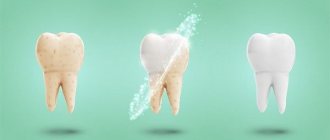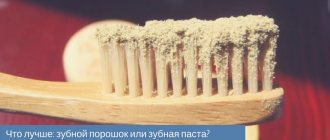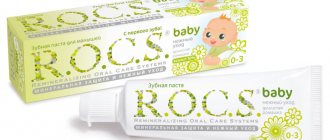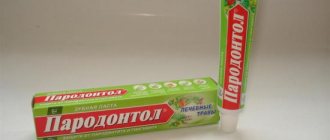“Secret” composition of toothpastes
The composition of the most ancient toothpastes, the recipes for which were found during excavations, included rather dubious substances: ashes of cow entrails, crushed egg shells, crushed pumice and... urea (yes, ammonia probably whitens teeth well).
The harm of the toothpaste used by the Egyptians (it was in Ancient Egypt that the recipe for toothpaste was found) can hardly be proven or disproved.
But the fact is that most of the popular toothpastes that we use today contain chemicals that are completely unsafe for our health
, we will tell our readers in detail today.
To answer the question of which toothpaste is the safest, you need to study its composition. Most toothpastes contain the following basic chemical elements: fluoride, triclosan, sodium lauryl sulfate
– they will be discussed in the article.
Foaming substance: aka sodium lauryl sulfate, aka SLS, aka surfactant
The most dangerous substance, which is part of 90% of toothpastes, is not fluoride, which has been talked about lately, but a foaming substance - sodium lauryl sulfate.
Most often it is denoted by three Latin letters SLS or Cyrillic - PAV.
It is this substance that, when it enters the oral cavity, foams and destroys plaque from tooth enamel.
This product is obtained by chemical synthesis of coconut oil.
. It is added to car detergents.
Dentists do not hide the fact that toothpastes containing sodium lauryl sulfate are dangerous to health.
The harm of toothpaste with SLS is also confirmed by ophthalmological studies: after using a toothpaste containing sodium lauryl sulfate, vision deteriorates by 5%.
Therefore, when choosing a toothpaste, pay attention to how it foams.
It turns out that the less foam, the better the quality of the toothpaste. The inscription SLS free
means that the paste contains
NO
foaming substance.
Eliminate bad breath
Rinse your mouth with 3% 3-4 times a day. 50 g of horseradish root, wash and peel the minced meat, pour in a glass of vodka, leave for 3 days, strain. Add a few drops to a glass of warm water and rinse your mouth. Folk remedies with antiseptic and anti-inflammatory effects, urban settlement Bezenchuk. Grind fresh horseradish root in a blender and squeeze out the juice through cheesecloth. Add to warm water and rinse your mouth several times a day. Grind 3c l leaves, 1c. l. Boil calendula flowers in two glasses of boiling water, simmer for 10 minutes in a water bath, let cool, strain. Use to rinse. Rinse your mouth with fresh cabbage juice diluted with the same amount of warm water. Gingivitis, periodontitis. Massage your gums with fir oil. Mix 3 parts oak bark, 2 parts linden blossom, brew 1c. L. Pour a glass of boiling water over the mixture, leave for 20 minutes, strain. Use to rinse. Folk remedies for wounds and ulcers. Boil 2 liters of crushed leaves with a glass of boiling water, leave for 15 minutes, strain. Rinse your mouth with warm infusion. Boil 1 liter of marsh grass with a glass of boiling water, leave for 45 minutes, strain. Rinse your mouth to heal the mucous membrane of the Privolny village.
- treat tooth Pridorozhny, Rassvet, Roshchino, Rivne-Rozhdestveno, Rybachy,
The dangers of fluoride in toothpaste
You've probably already heard about the dangers of fluoride in toothpaste? Is it true?
Let's start with the fact that the body's daily need for fluoride is 2 - 3 mg.
When American scientists discovered in the 40s that fluoride can heal holes in teeth - literally “patch them up” - it began to be added to all toothpastes. Soon the joy over this discovery subsided. They began to treat fluoride in toothpaste with caution and caution.
Still would! It turns out that this chemical element (“fluoride” is translated as “destructive”) is a toxic substance and its excess leads to tooth decay.
With an excess of this toxic element in the body, phosphorus-calcium metabolism is disrupted. This has been proven by many studies. excess fluoride gets directly onto the tooth,
. First, white spots appear, then they turn yellow and then the tooth enamel is destroyed.
Today, serious research is being conducted, the results of which confirm not the benefits, but the harm of fluoride in toothpaste.
Excess fluoride in the body not only causes dental problems, but also leads to brain diseases. It should also be taken into account that fluoride accumulates not only in teeth, but also in bones
. It can change the structure of bone tissue, even causing bone cancer.
Fluorine in the human body
Why is fluoride added to toothpastes? All this turns out to be commercially profitable. This is described in detail in K. Bryson’s book “Fluorine – the Big Deception”, where the myth about the benefits of this chemical element for humans is revealed.
We can get the daily amount of fluoride needed for our teeth by eating, for example, only 3 apples.
But the most important source of fluoride is water
! When buying toothpaste, do you consider what kind of water comes out of your tap? Hardly. But in vain!
The fact is that in many regions of Russia, water already has a high fluorine content (for example, in the Leningrad and Nizhny Novgorod regions, in Mordovia, Western Siberia, and some areas of the Moscow region). Residents of these regions only need to drink 1 liter of water to get half the daily fluoride requirement.
In Russia and Ukraine, there is a water fluoridation program, according to which fluoride is added to the water before it enters the water supply. In addition to water and apples, fluoride is found in fish and tea. That is, a person receives the daily amount of fluoride necessary for teeth from water and food
. Why add it to toothpaste?
The list of diseases that are caused by excess fluoride in the body could take half the article, so we will not list them.
The main conclusion: the safe amount of fluoride needed by our teeth enters the body through water and food. Therefore, it is better to choose toothpaste without fluoride.
Especially for residents of those areas where the water already contains fluoride compounds.
A safe fluoride-free toothpaste must contain calcium, which binds excess fluoride ions and remineralizes teeth.
Sympaty.net advises residents of those regions where the water contains high amounts of fluoride to use water filters
, which will cleanse it of excess of this chemical element.
Prevention of oral diseases
Tooth and gum diseases can be prevented by regular oral hygiene. When rinsing with warm water after each meal, add a drop of lemon juice to the water. Hydroalcoholic extracts of medicinal plants are useful - for example, chamomile and calendula. Chew your food thoroughly...Solid foods naturally massage and strengthen your gums, improve circulation and reduce the risk of oral disease. Many microorganisms live in the mouth. If oral hygiene is not observed, teeth, gums and mucous membranes hurt. The infection spreads throughout the body, penetrates the internal organs, causes arthritis, hearing impairment, and smell impairment. Microbial waste enters the bloodstream, placing increased stress on the kidneys, heart, and digestive system. Caries is the softening and destruction of tooth tissue, causing a cavity to form inside the tooth. The exact cause of the disease is unknown, the most likely are hereditary predisposition, abuse of sweets, baked goods, deficiency of calcium, fluorine, phosphorus, poor oral hygiene, which slows down the development of caries.
Gingivitis affects the gums, the development of pathology is facilitated by dysfunction of the endocrine system, malocclusion railway siding Razinsky
The gums are itchy, swollen, and there is bleeding between the teeth. The shape of the wounds is bad. The treatment uses antiseptic rinsing solutions and scrapes off periodontal pockets. Stomatitis. The inflammatory process in the mucous membrane often develops after measles and viral diseases. Triggered by vitamin deficiency, general intoxication, diseases of the digestive, endocrine, nervous system, disorders, and inappropriate oral hygiene. Stomatitis develops after mechanical damage to the mucous membrane, the wound turns into a non-healing ulcer. The gums hurt, swell and bleed, with a characteristic white color... The disease is treated with antiseptics, taking multivitamins in the villages of Novoorenburgsky, Sosnovka
Halitosis (bad breath)
The reason is excessive proliferation of microorganisms, the disease develops with insufficient hygiene of the oral cavity, base of the tongue, palate, caries, when it is difficult or impossible to thoroughly clean the affected area, removal of food debris, insufficient salivation, which naturally cleanses the oral cavity. An unpleasant odor occurs during periods of exacerbation of chronic diseases of the ENT organs, gastrointestinal tract, increased levels of female hormones - they cause desquamation of the epithelium of the mucous membrane and increase the population of microorganisms that emit hydrogen sulfide in the villages of Aleksandrovka, Verkhnepecherskoye, Vladimirovka. Tartar forms compactions of plaque that is deposited where the tooth contacts the gums and in the spaces between teeth. Dental plaque consists of food particles, mucus, and pathogenic microorganisms. The color is gray or dirty yellow; in smokers it is dark or black. Tartar can cause the development of gingivitis, and later periodontitis. The deposits are removed in the dentist's office using a special ultrasound machine. Periodontitis... The tissues surrounding the tooth are inflamed. There is a burning sensation, itching, tingling in the gums, redness or cyanosis, swelling as if creeping along the tooth, and bad breath, Kanuevka village,
village of Plodosovkhoz. On the other hand, as the disease progresses, the gums slide down, exposing the neck of the tooth and releasing pus and blood when squeezed. Over time, teeth become loose and fall out. Pokrovka village, Sretenka village;
Rural settlement Kupino. The disease occurs after 30 years of age, its causes are a lack of vitamins P and C, endocrine system disorders, tartar, non-healing caries, malocclusion, inappropriate oral hygiene Nizhneobrocheno, Novonatalino, Potulovka
Hydrogen peroxide for oral hygiene
It is believed that one of the causes of caries and periodontitis are food particles that remain in the oral cavity. In fact, rotting food particles rarely cause caries - teeth are destroyed when eating modern food Prepolovenka village, Ekonomiya village;
Rural settlement Priboy. Eskimos, representatives of island tribes, never brush their teeth or buy modern products, but many “civilized” people envy the health of their oral cavity. Proponents of the treatment advise regular oral hygiene with 3% peroxide mixed with food or non-fluoride toothpaste; After brushing your teeth, rinse your toothbrush with peroxide; In the morning and after lunch, rinse your mouth with a 3% solution of peroxide and water. For diseases of the mucous membranes - ulcers, inflammation - rinsing with this hygienic product is also used. With ENT diseases, mucus (snot) accumulates in the nasal passages, and an infection develops - the cause of the stench.
Recipe for getting rid of bad breath
Dilute 15 drops of 3% peroxide in a tablespoon of water. Apply twice daily into each nostril. Home remedies for the oral cavity Chelno-Vershinsky, Shentalinsky district Toothache. Rinse your mouth with a warm decoction of sage and yarrow for a long time - hold the liquid in your mouth for several minutes. Using chewing gum, fix a piece of camphor on the sore tooth. Mix 2 parts oregano, 2 parts Hypericum perforatum, 4 parts. Boil 300 ml of boiling water for 3 seconds. Mix the mixture, simmer over low heat for 2 minutes, leave for 2 hours, strain. Use for oral hygiene, remove unpleasant odor 2-3 times a day Stavropol, Khvorostyansky district Stomatitis. Perform oral hygiene by rinsing with a seven-day infusion. Wash and chop fresh grass, 2 l. pour a glass of sea buckthorn oil, leave in a cool, dark place for two days, strain. Lubricate the oral mucosa several times a day. Boil 1 tbsp. Hypericum perforatum and 1c. L. Pour a glass of boiling water over chamomile, leave for half an hour, strain. Rinse your mouth if you have diseases of the mucous membranes. It is useful to chew fresh parsley - it is an excellent antiseptic and promotes wound healing. Take orally a mixture of fresh juice and potatoes (2 c. L. four times a day), as well as a mixture of parsley juice and potatoes (3 c. L. 1 time a day)
Antibiotics...in toothpaste?
The antibiotic
triclosan
, which is part of the most popular toothpastes , can be no less dangerous than fluoride This antibiotic is added to kill harmful germs and bacteria in the mouth.
However, triclosan destroys not only pathogenic organisms, but also beneficial bacteria and microbes in the mouth.
In this case, harmful bacteria appear again, and useful bacteria, those that fight harmful microorganisms, may disappear altogether.
Historical reference
The ancient Romans, instead of toothpaste, used natural remedies at hand - plant roots, wood ash, resin. ZP in tubes appeared only in the 19th century - such a hygienic product was to the taste of the public, so it quickly replaced natural “analogs” from everyday use.
Important! Currently, in pharmacies, in addition to toothpaste, you can also find tooth powder - this is chemically precipitated chalk, enriched with useful additives and flavorings. It is not harmless: a large number of abrasive particles in the composition of the product, when used regularly, negatively affects the condition of tooth enamel, injuring and erasing it.
The safest toothpaste: how to determine?
In the United States, warning labels are placed on tubes stating that if you swallow toothpaste, you should immediately consult a doctor for help in case of poisoning. Not only will you not find a warning label on the tubes of our toothpastes, but the composition is often not even indicated. It is usually listed on the packaging, which is thrown away.
But still, a tube of toothpaste can tell us something. Have you ever noticed that toothpaste tubes have horizontal stripes of red, black, green and blue? Do you think it's just design? You are wrong. So information about the composition.
- Thus, a black
horizontal stripe indicates that the paste contains substances that increase periodontal disease. Such toothpastes should not be purchased by people with gum disease. - But the red
stripe indicates that the paste contains substances hazardous to health, such as fluorine, lauryl, triclosan, polyethylene glycol (PEG), oxybenzene, etc. - A safe toothpaste containing synthetic substances will have a blue
stripe on the tube. - The safest toothpaste has a green
label. A green stripe indicates that the paste consists only of natural raw materials.










